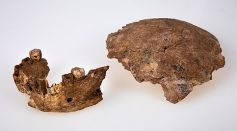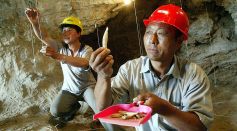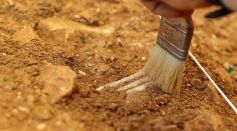Tags: Homo Sapiens

When Did Homo Sapiens First Appear?

Ancient Skull Fragments Discovered in Ukraine Suggests Early Modern Humans in Europe Descended From the East
World's Oldest Known Burial Site Was Made by Small-Brained Distant Relatives of Humans

World's Oldest Wooden Structures Dating Back Up To 476,000 Years Found in Zambia; Discovery Could Rewrite Human History
Oldest Human Remains: Controversy Surrounding Omo I’s Actual Age Explained

Hip Bone Fossil Discovery in France Suggests Coexistence of Different Human Lineages During Ancient Times

Ancient Human Presence in Southeast Asia Pushed Back to 86,000 Years with New Discovery in Laos Cave
Homo naledi May Have Been First To Bury Their Dead, but Skeptics Are Doubtful About This Claim

Oldest Known Homo Sapiens' Footprints Found in South Africa; Findings Reveal Prehistoric Presence of Early Humans in the Area

Archery Bows Show Homo Sapiens Existed 54,000 Years Ago, Traditional Weapon Found ‘Too Light to be Efficient’

Who Made the First Stone Tools? Evidence in 2.9-Million-year-Old Butchery Site Shows They Were Not Crafted by Humans

Neanderthal Art Over Time Suggests Their Changing Social Structures, Scientist Says

Hominins Sailed the Mediterranean Sea 450,000 Years Ago Even Before the Evolution of Homo Sapiens, Study Claims
Acheulean Tool-Making Tradition May Have Persisted Until About 177,000 Years Ago Before Homo Sapiens Arrived
7,200-Year-Old Young Female Skeleton Discovered in Indonesian Island; ‘Toaleans’ New Type of Ancient Human Seen in Fetal Position
Neanderthal, Denisovan Blood Group Analyses: Study Confirms Hypotheses on Their Origin, Dispersal, and Interbreeding with Homo Sapiens
Ancient Ostrich Eggshell Shows Proof Homo Sapiens Experienced Climate Change 250,000 Years Ago
Climate Change May Have Affected the Body and Indirectly the Brain Size of Prehistoric Humans, Study Found
Unicorn Bones Found? Nope, Neanderthals Just Carved Artwork on Toe Bone of Extinct Giant Deer
51,000-Year-Old Bone Carving Discovered in Northern Germany: Evidence of Neanderthals' ‘Sophisticated Behavior’
Most Popular

Coral Bleaching Crisis: How Ocean Warming Threatens Marine Ecosystems Worldwide

NASA Aurora Research Reveals How ESA Space Weather Teams Use Satellite Aurora Imaging and Ground Sensors

El Niño and La Niña Explained: How Climate Cycles Drive Extreme Global Weather Patterns

Can EV Batteries Be Recycled? How Lithium Recovery Supports Sustainable Batteries





